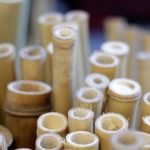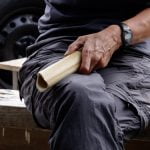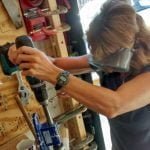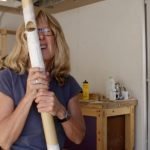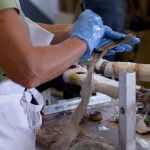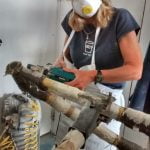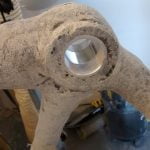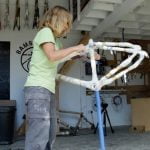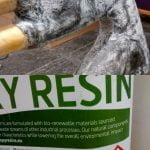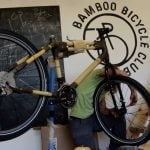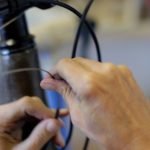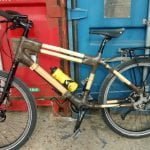Meet Woody
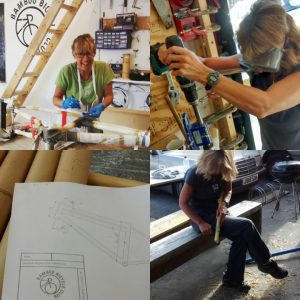
Photo credits: Lizzie Gilson, James Marr, Kate Rawles
My steed for the 8288-mile Life Cycle journey was Woody, a bike I built with (a lot of) help from The Bamboo Bicycle Club in London. The bamboo came from the Eden Project in Cornwall, and the joints are made from Yorkshire hemp soaked in ‘Super Sap’, a European Eco-Resin – probably the UK’s first home grown bicycle!
I spent five days at The Bamboo Bicycle Club in London, learning how to cut and shape the bamboo and then build the bike. It’s the frame that’s bamboo – the rest is assembled from standard mountain bike components. The bike is not the lightest – about 16.5kg including pannier racks – but by the time you add four panniers and a tent (I haven’t yet been converted to light-weight bike-packing!) the weight of the bike probably doesn’t make that much difference. More important was strength: Woody was designed to be a really tough mountain-bike/tourer.
It’s quite something to start with a pile of canes and end up with a bike – I’d never built one before – and the big question was, would it work? Would it be capable of carry carrying me and my kit for thousands of miles off and on road, across all sorts of terrain, in all sorts of conditions, from hot and dry to hot and humid to cold and wet? There was real uncertainty about this, in my mind at least, but Woody turned out to be the most reliable bike I’ve ever owned. I had hardly any mechanical problems on the whole journey and it was a smooth and shock-absorbing ride.
There’s more information about the bike and components in this ‘My Bike’ piece for Cycling magazine here:
I don’t really remember when I finally decided to build a bamboo bike for this journey, but it ended up being a brilliant choice. The bamboo frame means that overall, the bike has a smaller CO2 footprint than your average steel or aluminium tourer. Not that the CO2 footprint of any bike is exactly huge, and cycling is of course a fantastically low-carbon way of travelling (though it does depend what you eat! See the blog link here and below.) The frame is biodegradable when that sad day comes and the whole ethos of using a natural, sustainable material fitted perfectly with the aims of the trip. In the huge adventure that is our transition to a sustainable future we will still need stuff – but our stuff needs to be created from different materials in different ways with vastly lower environmental and other impacts across their whole life cycle; while still being beautiful, functional, fun. The bamboo bike is a great symbol of this transition I think. And of course I loved the idea of doing a biodiversity bike ride on a bike that used to be a plant.
It helped hugely with the communication side of things, too, both in South America, where Woody created huge interest everywhere we went, and now that I’m back. Lots of people cycle the length of South America but not so many on a bamboo bike they’ve built themselves. And the fact that I’d built the bike helped me maintain it in on the road.
More on the process of constructing the bike in the blog ‘How to build a bamboo bike’ and on the rationale in ‘Why to build a bamboo bike’.
Bamboo is an amazing substance. It’s one of the fastest growing plants on earth – it can grow up to a metre per day! – and while it shoots upwards it absorbs more CO2 from the atmosphere while than your average tree. You can harvest it without having to dig up the roots. It’s fantastically tough and versatile, used for scaffolding and building around the world. I visited a brilliant project in Cali, Colombia, where previously unemployed young men were being trained to build bamboo bikes, that were then sold locally and cheaply to encourage more cycling. There are bamboo bike projects in various parts of the world, from Ghana to the Philippines to Spain.
Woody, when not at slide show talks, is now on display in my ever-helpful local bike shop, Ride Bikes in Ulverston, who were hugely helpful in getting me and Woody ready for The Life Cycle. Hopefully there will be more road trips for us both ahead…
Meanwhile, more on bamboo, why Eden Project founder Tim Smit would take it to a new planet and a whole new take on meeting the relatives in this lovely Eden Project podcast here.
A short film about the process of building the bike, and the aims of The Life Cycle trip, can be found on You Tube Kate Rawles, thanks to Lizzie Gilson.
